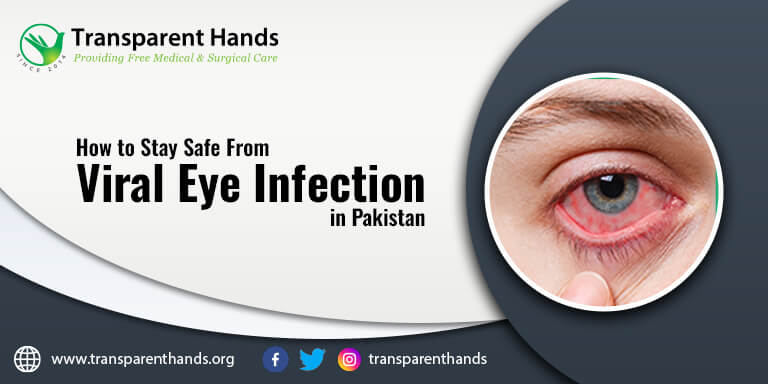How to Stay Safe From Viral Eye Infection in Pakistan

Conjunctivitis, also known as pink eye, is a common eye infection that causes redness, itching, and discharge. It can be caused by bacteria, viruses, or allergies. Conjunctivitis is very contagious and can easily spread through contact with infected eyes, hands, objects, or surfaces. Currently, the viral eye infection in Pakistan is running rampant.
Conjunctivitis is called pink eye because it causes inflammation of the conjunctiva, the clear tissue that lines the outside of the eye and the inside of the eyelid. The inflammation makes the conjunctiva red, which makes the whites of the eye appear pink or red.
How can you catch it?
To understand how conjunctivitis moves around, it is important to understand its types.
There are four main types of conjunctivitis:
Bacterial conjunctivitis: This is the most common type of conjunctivitis and is caused by bacteria. Its symptoms include a thick, yellow, or green discharge from the eye.
Viral conjunctivitis: This type of conjunctivitis is caused by viruses, such as the adenovirus, which is also responsible for the common cold. It can be identified by a watery discharge from the eye, as well as other symptoms of a cold, such as a runny nose and sore throat.
Allergic conjunctivitis: This is caused by an allergic reaction to something in the environment, such as pollen, dust mites, or pet dander. It is often accompanied by redness, itching, and watery discharge from the eye.
Irritant conjunctivitis: This type of conjunctivitis is a result of exposure to irritants, such as smoke, chlorine, or cosmetics. Its symptoms are redness, itching, and a burning sensation in the eye.
In some cases, conjunctivitis can be caused by a combination of factors. For example, a person with bacterial conjunctivitis may also have an allergic reaction to the bacteria.
Now that we have identified the condition’s different types, conjunctivitis causes can be attributed to the following factors:
Contact with secretions from the eye of an infected person: Pink eye can spread easily through contact with the tears, mucus, or pus from the eye of an infected person. This can happen when someone touches their own eye after touching the eye of an infected person, or when they use a contaminated object, such as a towel or pillow.
Exposure to irritants: Conjunctivitis can also be caused by exposure to irritants, such as smoke, dust, chlorine, or cosmetics. These irritants can inflame the conjunctiva.
Exposure to allergens: Pink eye can also be caused by exposure to allergens, such as pollen, dust mites, or pet dander. When someone is allergic to a substance, their body produces an antibody called histamine. Histamine can cause inflammation of the conjunctiva, leading to conjunctivitis.
Extended use of contact lenses or unhygienic practices: Contact lens users are at increased risk for developing conjunctivitis, especially if they wear their contact lenses for extended periods or do not wash their hands before touching their eyes or contact lenses. This is because contact lenses can trap bacteria and other irritants on the surface of the eye, which can lead to infection.
How to stay safe?
Wash your hands often with soap and water. This is the most important thing you can do to prevent pink eye. Wash your hands especially well after touching someone with pink eye or their personal items.
Avoid touching or rubbing your eyes. This can spread the infection to your other eye.
Do not share personal items. This includes makeup, eye drops, towels, bedding, contact lenses and containers, and eyeglasses.
Stop wearing contact lenses until your eye doctor says it’s okay. Clean, store, and replace your contact lenses as instructed by your eye doctor.
If contracted, what is the treatment?
Pink eye treatment is fairly simple. If you have bacterial or viral pink eye, you can try the following to relieve your symptoms:
1. Use over-the-counter lubricating eye drops (artificial tears).
2. Apply a warm compress to your eyes. To do this, soak a clean washcloth in warm water, wring it out, and place it over your eyes for a few minutes. Repeat this several times a day, or as often as is comfortable.
3. Use a clean washcloth each time to avoid spreading the infection.
4. If you have pink eye in both eyes, use a different washcloth for each eye.
5. If your eyelids are sticking together, you can use a warm washcloth to loosen the dried mucus so you can open your eyes.
For allergic and irritant conjunctivitis, the fastest method of getting rid of the infection would be to remove the irritant from the eye or avoid the allergen causing the reaction.
Conclusion:
The pink eye condition may be running rampant in Pakistan. It is known for fast and easy transmission but with adequate preventative measures, the mass population can stay safe. If symptoms prevail or get painful, it is advised to consult with a doctor immediately.
(The information in this article should not be taken as a substitute for professional medical advice.)










Leave Your Comments